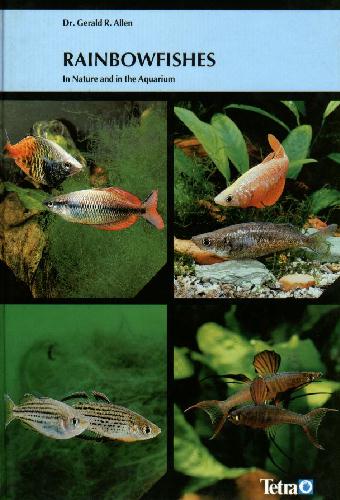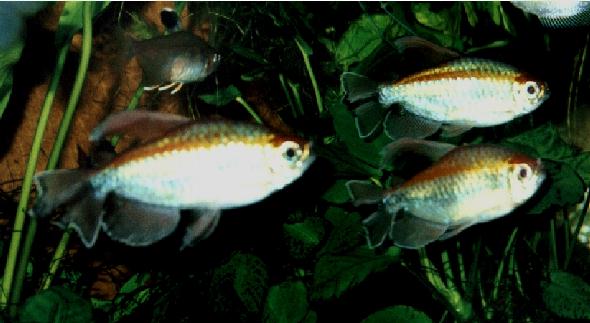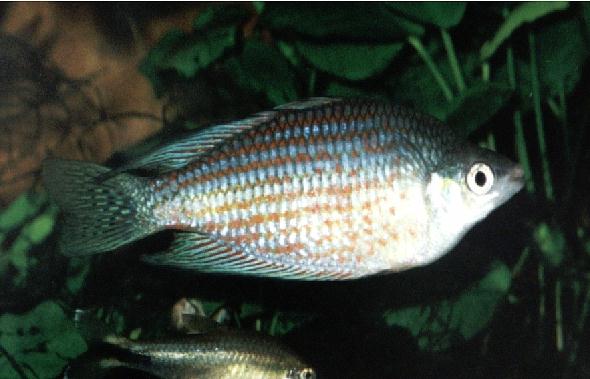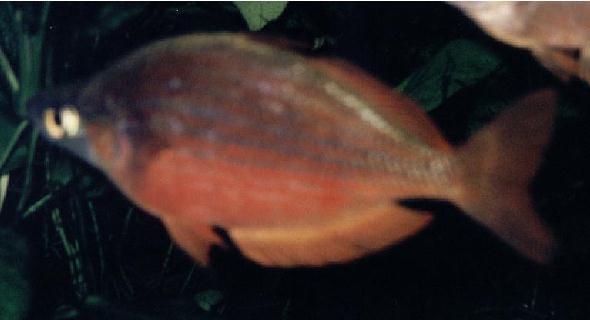RAINBOWFISH
& Blue-eyes
Rainbowfish have the unequivocal distinction of having the most beautiful fish listed in this group of varied and charming fish that I keep if not of all fish. The most stunning of which is Melanotaenia praecox, the Neon Dwarf Rainbowfish. It is a fish I have kept, bred and lost due to a moment’s negligence. Whenever I see it the awesome beauty of this fish it amazes me. No marine fish can match it in pure showmanship or intensity of splendorous color. I have now finaly got my hands on another trio of these wonders and I can't wait to have a spare tank open to breed them.
 My prize rainbowfish artifact is my copy of Rainbowfish in Nature and the Aquarium written by Dr. Gerald Allen in 1995 and published by Tetra-Verlag, Melle, Germany. If you can get a copy you are very lucky! This is one of the most sought after books on the rainbow scene and the second edition is very much awaited!!!
Harro Heironimus' Aqualog All Rainbowfish is spectacular!
My prize rainbowfish artifact is my copy of Rainbowfish in Nature and the Aquarium written by Dr. Gerald Allen in 1995 and published by Tetra-Verlag, Melle, Germany. If you can get a copy you are very lucky! This is one of the most sought after books on the rainbow scene and the second edition is very much awaited!!!
Harro Heironimus' Aqualog All Rainbowfish is spectacular!
I used maintain at least five species of the suborder Atherinoidei. Space and maintenace issues have forced me to cut down to two species: M. praecox and I. werneri. Of those I used to keep there was of course the ever-popular star of the ‘bow show: M. boesemani. This fish, defined by its schizophrenic color pattern: orange rear and navy blue head make it a constant and dependable seller in the pet stores. The predominance of males being purchased and sold robs the average fishkeeper of the true beauty of this fish. When spawning this fish’s forehead and nape changes color (a trait common to all Melanotaeniidae with all rainbows). The fish takes on remarkable neon green brilliance. I have the fortune of having my tank in morning sunshine with the result that many mornings I wake to the boesemani and other ‘bows and Congo Tetras (pictured below) playing in the morning sunshine with full color.
 This brings out the beauty of another ‘bow, my fomer favorite in my collection, M. splendidia rubrostriata (pictured above). In the morning sunlight and feeding time the crimson stripes on its flanks glow against the blue-gray backdrop of the body. The yellow speckling in the fins against the red and black streaks makes for a dazzling display. This fish breeds easy and is very productive. The fry grow quick and begin to show the hints of their adult color after about 5 months. At this point they are about 5 cm in size. The adults attain about 12 cm in the aquarium and gain a very deep profile typical of ‘bows.
This brings out the beauty of another ‘bow, my fomer favorite in my collection, M. splendidia rubrostriata (pictured above). In the morning sunlight and feeding time the crimson stripes on its flanks glow against the blue-gray backdrop of the body. The yellow speckling in the fins against the red and black streaks makes for a dazzling display. This fish breeds easy and is very productive. The fry grow quick and begin to show the hints of their adult color after about 5 months. At this point they are about 5 cm in size. The adults attain about 12 cm in the aquarium and gain a very deep profile typical of ‘bows.
Next on the list is the Kutubu rainbowfish, M. lacustris. This fish has a sky blue to neon green back and a pinkish white abdomen. The male’s color is more intense. Both sexes display a bright orange nape when spawning or displaying. This is more intense in the male. Unfortunately I lost my male before I could observe any spawning but a friend has had great success. He had a group of 6 fish in a 1.2 m tank with a dense cover of floating Hygrophilia on the surface. After 2 weeks fry started coming out of the plants and are doing great
The fourth rainbow is what I suspect to be a hybrid (yes the hybrid problem has reached the rainbowfish) between .G. incus and M. trifasciata. They were sold as “red pigeon rainbows” and are very attractive. I do not advocate the purchase of hybrids and am pitted against the intentional production of hybrid fish to fill the ‘yuppy’ fish market but this is a fish that must be seen to be believed. The body is a basic gray with orangey overtones with feint red stripes. When the fish is in the mood however those red strips shine with crimson red that cannot be described. It is superficially similar to C. blehri but has a classic trifasciata build and lacks the adult coloration of the blehri. The ultimate proof of it being a hybrid is its partner. This fish remains mostly dull and the red is never as intense. It is also a male however as both try to spawn with the female boesemani. Below is a blurred picture of this stunning fish. On occasion the red/orange colour is far more intense than in the picture.
 All my bow’s are kept in the soft water that flows from my tap. They breed in this and grow fine and are quite healthy. The fry of these fish are small and hug the surface. The surface feeding nature makes fry care very difficult. Tetra E works the best for me although some green water doesn’t do any harm. These fish tend to grow slowly but are worth the wait. In general the fish are hardy. The fry are less so. Changes in water quality will rapidly destroy a brood. The praecox don’t outgrow this trait. My shoal of praecox died suddenly one day; the cause was a sudden drop in pH. A largish fish had died in the dark corner of my planted tank and pushed up the NO3- with production of many free H+. The pair that survived never recovered. I got anopther a few months ago. In that time I have gone through 2 generations. Each time I have murderred the parents though stupidity. I am learning and hopefully the current group will live a long productive life.
All my bow’s are kept in the soft water that flows from my tap. They breed in this and grow fine and are quite healthy. The fry of these fish are small and hug the surface. The surface feeding nature makes fry care very difficult. Tetra E works the best for me although some green water doesn’t do any harm. These fish tend to grow slowly but are worth the wait. In general the fish are hardy. The fry are less so. Changes in water quality will rapidly destroy a brood. The praecox don’t outgrow this trait. My shoal of praecox died suddenly one day; the cause was a sudden drop in pH. A largish fish had died in the dark corner of my planted tank and pushed up the NO3- with production of many free H+. The pair that survived never recovered. I got anopther a few months ago. In that time I have gone through 2 generations. Each time I have murderred the parents though stupidity. I am learning and hopefully the current group will live a long productive life.
The Iriatherina werneri I have were lovely. Long flowing red fin extensions... the females were plump and I had no problem with the fry I got when I was collecting eggs. Things were going so well I decided to put the group outside and experiment. Well, a dragonfly had designs on the outside tub and the adults became lunch. The fry
had grown great till a small emergency forced me to put my large adult Fundulopanchax amieti into their tank. A mad dash ensued to resuce the baby threadfins but only 3 were saved... The fry took to Mike Reed's No-BS without any effort on my part. The surface hugging nature of rainbows and blue eyes is great for dried food feeding.
Most rainbows aren’t as touchy and are hardy and attractive fish well worth the often exorbitant prices that are asked for them.
Blue-Eyes, Australasia's answer to killifish.
These are all tiny to small fish spread over 3 genera:
Kiunga, Pseudomugil and Scaturiginichthys. There
is a vast variety of colours, patterns and forms.
My favourite blue-eye is Psuedomugil mellis, the Honey
Blue-eye. This little fish in endangered in its homeland of Eastern
Australia. This is sad as it looks like a lovely little fish. I have
been sent eggs of Ps. gertrudae in peat via post with fair
success (I got one pair that just happened to be a pair!). I was
able to get some Ps. signifer eggs from a friend and was able
to set up a small colony but alas lost them during a move.
The strain of gertrudea I have, Jones River, Cairns, Nth
Queensland, lacks the yellow fins as seen in most pictures and the
body is more white than blue. From the initial pair I raised I have
distributed this fish to several people and set up a spawning colony
of about 20 fish. They are not difficult to breed. I've kept them
with a range of fish (from Thread-fin rainbows to angelfish) and fed
them crushed flake, Mike Reed's No-BS fry food, micro-granulate by InterRyba, bbs and grindal worms on a
"what-ever-is-easiest-this-morning" basis. After being in the tank
with the threadfins for about 2 weeks fry were observed at the water
surface.
The signifer need salt and a high water temperature
(27°C) to breed and do well. The fry are smaller and more
delicate than those of the gertrudae which out compete them
for food. Males also drive the females very hard and can be very
aggressive towards each other. The adults eat anything offered.
I have been sent eggs of Pseudomugil mellis by post in damp
peat. While losses were high the seven fry that hatched did well.
Alas two fry turned into gertrudae. The five mellis fry
are growing well and beginning to colour up. They grow slower than
the gertrudae and are more picky about what they eat. I hope
to spawn them soon.
I have also been sent eggs of Pseudomugil furcata and
cyanodorsalis in wet wool. The wool with eggs was shipping in
⅓ strength sea water in Kordan breathing bags. All eggs
arrived viable and proceeded to hatch when fresh water was added.
While I lost the cyanodorsalis to a cunning notho hiding in
some java moss the furcata were doing well last time I saw
them (I passed them onto a friend with some furcata fry of his
own).
Last updated 1.10.06
 My prize rainbowfish artifact is my copy of Rainbowfish in Nature and the Aquarium written by Dr. Gerald Allen in 1995 and published by Tetra-Verlag, Melle, Germany. If you can get a copy you are very lucky! This is one of the most sought after books on the rainbow scene and the second edition is very much awaited!!!
Harro Heironimus' Aqualog All Rainbowfish is spectacular!
My prize rainbowfish artifact is my copy of Rainbowfish in Nature and the Aquarium written by Dr. Gerald Allen in 1995 and published by Tetra-Verlag, Melle, Germany. If you can get a copy you are very lucky! This is one of the most sought after books on the rainbow scene and the second edition is very much awaited!!!
Harro Heironimus' Aqualog All Rainbowfish is spectacular! This brings out the beauty of another ‘bow, my fomer favorite in my collection, M. splendidia rubrostriata (pictured above). In the morning sunlight and feeding time the crimson stripes on its flanks glow against the blue-gray backdrop of the body. The yellow speckling in the fins against the red and black streaks makes for a dazzling display. This fish breeds easy and is very productive. The fry grow quick and begin to show the hints of their adult color after about 5 months. At this point they are about 5 cm in size. The adults attain about 12 cm in the aquarium and gain a very deep profile typical of ‘bows.
This brings out the beauty of another ‘bow, my fomer favorite in my collection, M. splendidia rubrostriata (pictured above). In the morning sunlight and feeding time the crimson stripes on its flanks glow against the blue-gray backdrop of the body. The yellow speckling in the fins against the red and black streaks makes for a dazzling display. This fish breeds easy and is very productive. The fry grow quick and begin to show the hints of their adult color after about 5 months. At this point they are about 5 cm in size. The adults attain about 12 cm in the aquarium and gain a very deep profile typical of ‘bows.
